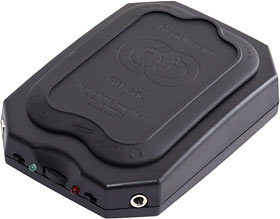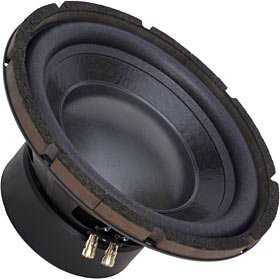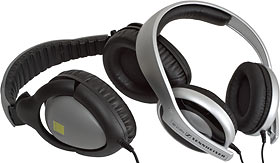
Head to head - headphones versus speakers
Originally published in Atomic: Maximum Power Computing. Last modified 03-Dec-2011.
Unless you've got RCA sockets hooked up to your auditory nerves, there are exactly two ways for you to listen to electrically reproduced music. Headphones, and speakers.
Both are, fundamentally, the same. Electricity applied to a transducer - usually electromagnetic, occasionally piezoelectric or electrostatic - creates sound waves. Speakers have big transducers that run at power levels in the multi-watt range; headphones have little transducers that run on milliwatts.
There are other obvious differences between headphones and speakers. Speakers let lots of people listen, whether they want to or not; headphones keep the sonic fun to one person (well, more or less). Speakers cost more - possibly a lot more - for similar fidelity. Speakers are less portable. Speakers can jiggle your kidneys with pumping bass; headphones can't. And headphones can be uncomfortable - though good ones aren't.
There's more to it than this, though. Headphones can actually mix it with speakers in more departments than you might think.
Two ears, eight speakers
Consider surround sound, for instance. If you've got 5.1 channels of audio (the 0.1 is the restricted-frequency-range subwoofer channel), then obviously five speakers and a sub, correctly set up, is the best way to reproduce it, right?
Well, that's certainly straightforward. Perfect speaker setup can take a while, but most people just plunk the things down and call the job done. Surround speakers also give a rigid audio frame of reference; while you're watching a surround sound movie, the sonic "front" is always in the same place, even if you turn away from the screen. With headphones, the soundstage turns with your head.
But for some surround sound, particularly 3D positional computer audio, headphones can actually work better than speakers.
The reason for this is that you've only got two ears. The way you tell whether a sound's in front, behind or above you, rather than just to your left or your right, is by processing the complex differences in phase, time delay and frequency balance that're imparted to differently located sounds by nearby objects (like walls), and by the sonic characteristics of your head.
Your pinnae - the outer parts of your ears - strongly influence sound waves that pass through and bounce off them. 3D game audio uses Head Related Transfer Function (HRTF) algorithms to fake the effects of the pinnae, the head and various listening environments, so that injecting the sound straight into the ear canal can produce the impression of real 3D audio sources.
When you've got HRTF-massaged two-channel audio already, for instance when you're playing a game, headphones are obviously the best way to get the sound into your head. There's no way for speakers to do the job as well, because there's no way for them to stop each ear hearing the sound that's intended for the other.
Getting ordinary surround sources like DVD movies into the right HRTF format for effective headphone listening, though, can be tricky.
If you're watching DVDs on your PC then you probably don't need to buy anything extra to get good surround through headphones. All of the most popular DVD playback programs these days have a software surround "virtualiser" for headphone listening, and modern CPUs are more than up to the task.
If you want to translate any arbitrary surround source into headphone audio, though, you need extra hardware - a headphone amplifier with surround encoding functions. These days, some amps like that come with matching wireless headphones for easy living-room listening, but they aren't cheap.
Another way of encoding surround for headphones is to, well, not do it, and just buy headphones with multiple drivers. These 'phones are like a little surround speaker rig you wear on your head, fed by the separate surround channels (except for the subwoofer channel), with no HRTF wizardry needed.
Zalman's RS6F "Theatre 6" 'phones are probably the best known of these among PC tweakers. They're cheap, too. The surround works well enough, but like most (if not all) multi-driver headphones, they don't actually sound very good.
Crossfeed

HeadRoom's BitHead headphone amplifier
has everything that opens and shuts, including a crossfeed processor.
The thing that makes speakers lousy for HRTF surround sound is also the thing that makes them good for music. Music is, almost always, mixed to sound good through stereo speakers. It's assumed that quite a lot of the left channel will be audible to your right ear, and vice versa.
Because headphones don't do this, music through them generally sounds as if it's all happening inside your skull. There's no stereo soundstage out there in front of you. For this reason, even very good headphones can become quite fatiguing to listen to, after a while. Generally, the more different the two stereo channels are, the more tiring it'll be to listen to them for hours on end through headphones.
The solution to this problem is a relatively simple HRTF called "crossfeed", which basically involves feeding an attenuated version of each channel to the other channel. It makes headphones sound more like speakers.
Crossfeed that sounds really good goes on to slightly delay and frequency-tweak the crossfed sound, to imitate what the head does to sound from the opposite side of the room. The result is a soundstage that's apparently moved forward towards where it should be, with less extreme stereo-ality. Just like speakers.
Bass

There's no replacement for air displacement when it comes to bass.
But bass shakers can vibrate the parts no speaker can reach.
Good headphones commonly have excellent bass response, but their teeny little drivers don't move bulk air like a big speaker. Your ears hear just as much bass as a speaker can deliver, but the rest of you remains unmoved.
For ordinary headphone listening, the lack of floorboard-shaking bass is a problem that can't be overcome.
If you're particularly dedicated, though, bolting one or more "bass shakers" to your listening chair will give you the kidney-kicking effect of a giant subwoofer without much actual noise. A few companies make shakers, which are mainly used in conjunction with subwoofers; the shakers cover the ultra-low frequencies found in action movie soundtracks, computer games and so on. But shakers can be used with headphones, too.
Isolation

Closed-back headphones; the music-loving
overclocker's friend.
Speakers can only try to drown out ambient noise. Sealed headphones block it out.
Many of the best-sounding headphones are "open", with a grille on the outside of the ear-cups that lets the rear pressure wave from the diaphragms out. Open headphones let through pretty much all ambient noise, which is good if you're expecting to be called for dinner but bad if you're on a bus.
Closed-back headphones make each ear-cup into a little sealed speaker box. They can sound great, too (and can easily be tuned for phat bass...), and if they make a decent seal around your ears they can block the drone of a computer room or the racket of a LAN party very effectively.
You can also get active noise cancelling headphones, and they generally work pretty well, especially with some particular kinds of noise - the cabin racket of a jet airliner in particular.
But why bother with something that needs a AAA battery when a big set of sealed 'phones, or a tiny set of in-ear "canalphones", will actually work just as well?

